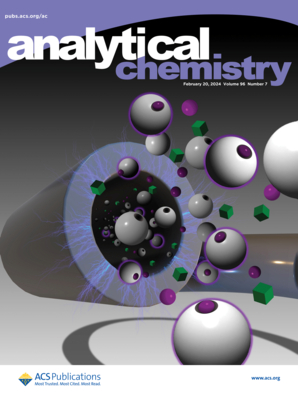Investigating Metabolic Pathways of Ankylosing Spondylitis via Compound Similarity Network-Assisted Metabolomics Analysis.
IF 6.7
1区 化学
Q1 CHEMISTRY, ANALYTICAL
引用次数: 0
Abstract
LC-MS-based metabolomics is a powerful tool in analyzing disease molecular mechanisms. Because of its high sensitivity and throughput, LC-MS-based metabolomics usually detects thousands of metabolites. How to find disease-related metabolites and investigate metabolic pathways is critical in metabolomics studies. Conventional statistics-guided data mining looks only for mathematical relations between the detected metabolites and the metadata. It is not enough to unveil biological pathways of metabolites involved in disease progression. Compound similarity network (CSN) is a spectral-independent technique to cluster compounds based on their structural similarities and to investigate potential chemical transformations. Herein, we developed a CSN-assisted metabolic data mining strategy to quantitatively find key metabolites in diseases through structural similarities and explore disease-regulating metabolic pathways based on KEGG and RetroRules metabolic reaction templates. The strategy was used in a metabolomics study of ankylosing spondylitis (AS), in comparison with a healthy cohort and rheumatoid arthritis (RA), a rheumatic disease having similar symptoms with early AS. Using CSN-assisted data mining, a palmitic acid pathway was constructed, which may be regulated in AS pathogenesis.通过复合相似网络辅助代谢组学分析研究强直性脊柱炎的代谢途径。
基于lc - ms的代谢组学是分析疾病分子机制的有力工具。由于其高灵敏度和高通量,基于lc - ms的代谢组学通常检测数千种代谢物。如何发现疾病相关代谢物并研究代谢途径是代谢组学研究的关键。传统的统计导向数据挖掘只寻找检测到的代谢物和元数据之间的数学关系。这还不足以揭示代谢产物参与疾病进展的生物学途径。化合物相似网络(CSN)是一种基于结构相似性聚类化合物并研究潜在化学转化的光谱无关技术。为此,我们开发了一种csn辅助的代谢数据挖掘策略,通过结构相似性定量发现疾病中的关键代谢物,并基于KEGG和retrorrules代谢反应模板探索疾病调节代谢途径。该策略用于强直性脊柱炎(AS)的代谢组学研究,与健康队列和类风湿关节炎(RA)进行比较,类风湿关节炎是一种与早期AS症状相似的风湿性疾病。利用csn辅助数据挖掘,构建了一条可能在AS发病过程中受到调控的棕榈酸通路。
本文章由计算机程序翻译,如有差异,请以英文原文为准。
求助全文
约1分钟内获得全文
求助全文
来源期刊

Analytical Chemistry
化学-分析化学
CiteScore
12.10
自引率
12.20%
发文量
1949
审稿时长
1.4 months
期刊介绍:
Analytical Chemistry, a peer-reviewed research journal, focuses on disseminating new and original knowledge across all branches of analytical chemistry. Fundamental articles may explore general principles of chemical measurement science and need not directly address existing or potential analytical methodology. They can be entirely theoretical or report experimental results. Contributions may cover various phases of analytical operations, including sampling, bioanalysis, electrochemistry, mass spectrometry, microscale and nanoscale systems, environmental analysis, separations, spectroscopy, chemical reactions and selectivity, instrumentation, imaging, surface analysis, and data processing. Papers discussing known analytical methods should present a significant, original application of the method, a notable improvement, or results on an important analyte.
 求助内容:
求助内容: 应助结果提醒方式:
应助结果提醒方式:


